
As promised, here’s the tale of a recent fountain pen acquisition, an Aurora 88 Minerali Diopside. Last fall was my birthday, and I was told to buy two pens that I ordinarily wouldn’t buy for myself.
Since obtaining the Aurora 2Cart last year, I’ve been thinking once again about nibs. One of the best writing nibs I ever had was made by Aurora, an Extra-Fine 14K housed in an Aurora Optima Mini. I no longer have that pen, but the nib had a unique personality I’ve never forgotten—like writing with a soft pencil.
A modern Aurora 88 was my choice. I wanted a no-fuss pen with decent ink capacity, which meant getting the larger piston-filling 88, a modern 88, not a vintage one. The modern version because of my “no-fuss” desire—a pen that could be carried outside the house without worrying about it barfing ink at will.
Why not get another Aurora Optima Mini? Well… whenever I’ve tried to recreate a pen experience, or even obtaining a “duplicate” of a pen, the experience isn’t the same and often disappointing. YMMV.
An Aurora 88 was my choice because it’s a classic, iconic pen in the pen world. Plus, unlike many pen manufacturers, Aurora still makes its own nibs and feeds.
Given the renowned beauty of Italian resins, it’s ironic I chose a pen with a clear resin.

Aurora 88 Minerali clear barrel, cap, green ends, and ring band
The Minerali was made in 2017 in limited numbers. I don’t seek limited edition pens, but I was drawn to this one with the green ends. I like the look of the pen, and I needed a touch of green in my life.
What the heck is Diopside anyway? A green mineral. All five-colored Mineralis represented minerals: Azurite, Amber, Amythest, Cinnabar, Diopside. However, the colors are not made from minerals but from Auroloide, Aurora’s fancy name for cellulose acetate. The green is very bright and beautiful no matter what it’s called.
The Aurora Double-Broad (BB) nib was a clear favorite among my Italian pen collector pals, and that was the nib I decided to get. I wanted to step outside my normal nib choice.
The Aurora 88 Minerali with the Double-Broad nib came from Vanness Pens, whose customer service is always outstanding. The pen was on sale and even further discounted on Fountain Pen Day. The cost was less than a plain, black large Aurora 88. A guilt-inducing steal, deal, for sure.
The BB nib was/is very broad and italic. If you like italics, you’ll probably like the nib.
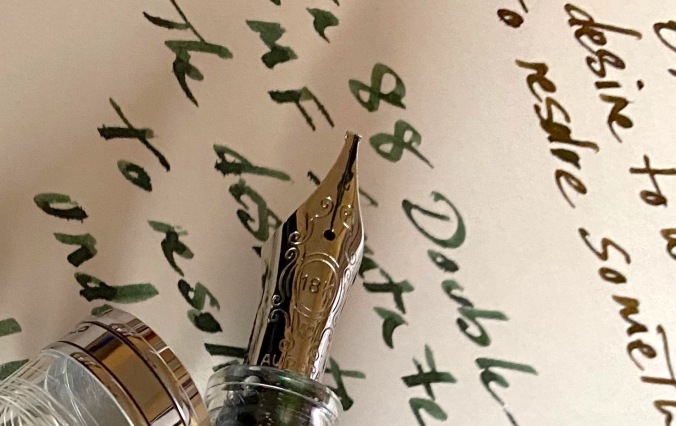
Can you see the nib’s anvil-shaped tip? This one was quite sharp.
Ultimately I decided the BB nib was not for me. It was too wide, too sharp, too italic-y. I considered keeping the BB and buying a second nib for everyday use. Aurora’s nib units can be easily unscrewed and exchanged. But the cost of a single nib unit is very close to the cost of a pen.
Also, I didn’t want to send the pen off to have someone re-grind a good nib into something else. I wanted a nib “out of the box” that just worked as-is.
Aurora’s US distributor Kenro exchanged the BB nib for a factory Stub. That was a free service Kenro provided, and the Kenro folks were an absolute joy to deal with. I sent them the pen the week of Christmas and didn’t expect to see the 88 again for several weeks. It came home the very next week!
The Stub nib is perfect for me. “Just right,” as Goldilocks would say. The width is smaller than the BB, and the nib’s super smooth, depending on the writing paper. It’s a very different experience than my first Aurora because the nib lacks that “soft pencil” feel. But the stub nib provides an immensely pleasurable writing experience.
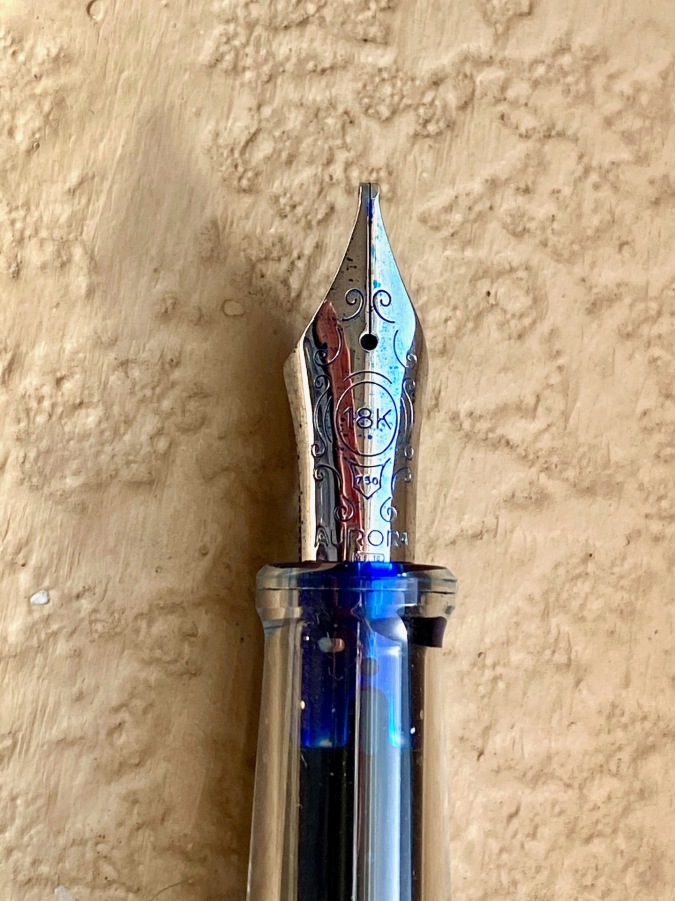
Aurora 88 Stub
In the photo below, you can see how the BB and Stub compare. A TWSBI Eco Stub is represented, too. By my measurements, the downward strokes are Aurora Stub 1.1mm, Aurora BB 1.4mm, TWSBI Eco Stub .9mm.

left to right: Aurora Stub, Aurora Double-Broad, TWSBI Eco Stub, Aurora Stub
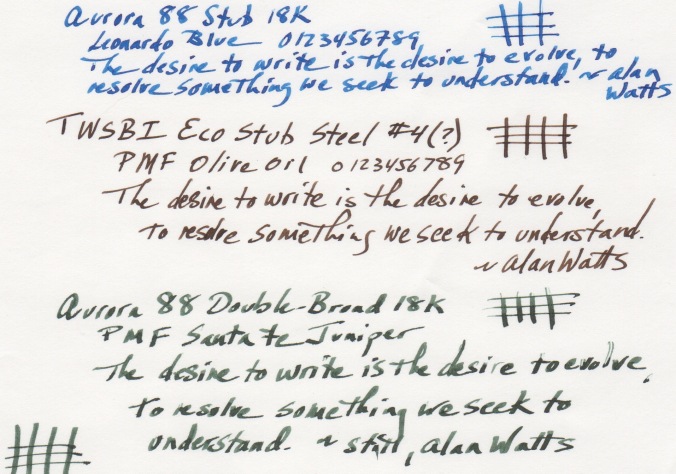
Both the Aurora and TWSBI Eco stubs are a no-brainer for everyday writing. Because large italics perform better the slower you write, I’d reserve the Aurora BB for special, occasional writing. Perhaps signing a book or writing a short note to someone.
Trying the BB nib helped me realize what I truly wanted and needed: a nib to use for everyday writing; a stub nib for a bit of flair. In picking a stub, I ended up with my favorite type of nib. So much for stepping outside my box of nibs, ay?
The Stub nib is paired with an ebonite feed, also made in-house by Aurora. Ebonite is a far better conduit than standard plastic feeds for “feeding” ink to the nib. IMHO.
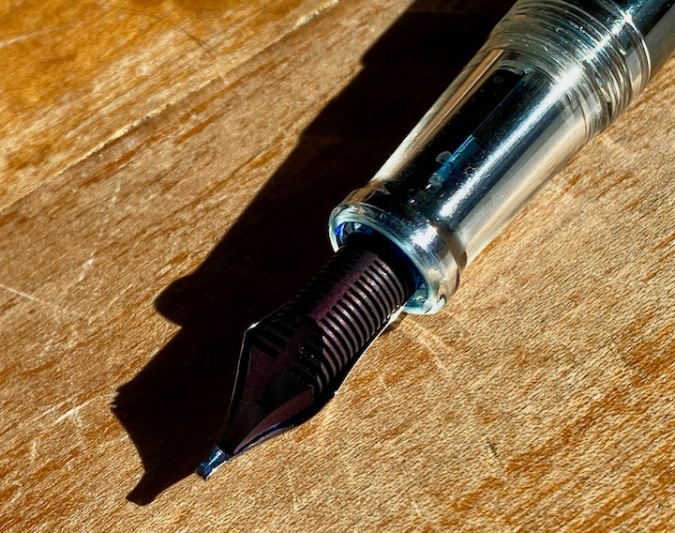
Aurora ebonite feed
The Aurora 88 Minerali is one of the best-weighted pens I’ve written with. It’s well-balanced, not too heavy, and not too light. The piston is smooth and sturdy to operate. The piston knob doesn’t wiggle around. The pen was easy to clean. Combined with the stub nib, I love this pen and haven’t been able to put it away.

Aurora 88 inked with Leonardo Officina Blue
The Aurora 88’s not an inexpensive fountain pen. But it’s well-made, backed by the manufacturer, and holds a decent amount of ink (around 1.3/1.4ml). Any writer would probably enjoy this pen. It could be the only pen in one’s tiny hoard, too.
Bear in mind that a new pen often takes the favorite spot for a period of time until it settles down amongst the others. But I can see a fountain pen collection of two: the 88 and a Pilot Decimo for notes. Okay, three, because I can’t give up my Hakumin Edison Mina. Okay… um… I won’t make any changes or predictions just yet. More to be revealed as I write along.

possible writer’s trio
I’m glad to have such an iconic Italian fountain pen in my collection. (Not a “review,” simply sharing my experience.) No regrets. (Thank you, honey.)
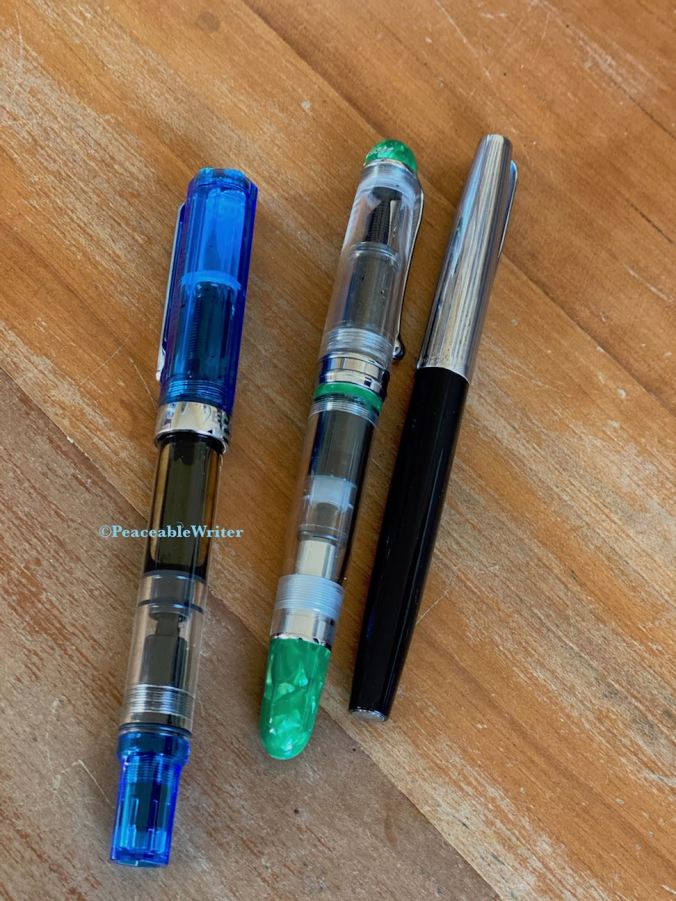
TWSBI Eco, Aurora 88 Minerali, Aurora 2Cart
If you remember, I mentioned a birthday gift of two pens. The second pen was another Italian, a Leonardo Momento Grande. More about that pen in the future.

Aurora 88, Pilot Decimo, Leonardo Momento Grande
For more information about Aurora fountain pens, there’s a long list of links at the end of this post I wrote last year: (my apologies—I had the wrong link listed between March and August)
Also here’s an article link about the Aurora’s hidden reservoir system, from the well-missed (not defunct) shopwriter’s bloc blog.
Reading
I finished Natalie Goldberg’s Three Simple Lines, A Writer’s Pilgrimage into the Heart and Homeland of Haiku. And then I reread it. I’m sure I’ll read it several more times. I liked the book so much, I signed up for the Upaya Zen Center‘s annual Haiku event. This year featured the book, and the event was called Three Simple Lines – Haiku as Refuge in Our Time. With Roshi Joan Halifax, Clark Strand, Natalie Goldberg, and the great calligrapher Sensei Kaz Tanahashi, the informative and beautiful event is available online. A donation when you sign-up would be greatly appreciated by Upaya, especially during these times of financial woes. Haiku and Buddhism have a long history together, but you don’t have to be a Buddhist to appreciate haiku. (I’m not.) Goldberg’s book is available as ebook, hardback, or paperback.
Seeds from a Birch Tree, Writing Haiku and The Spiritual Journey by Clark Strand is another book I read. This book is out-of-print, but I managed to borrow a copy. Check your library for a copy. Hopefully, it will be reprinted. While Goldberg suggests letting go of the 5-7-5 haiku form, Strand insists the 5-7-5 syllable lines are to be embraced. The book depicts both Strand’s spiritual journey from haiku to Buddhist monastery back to haiku and good instruction on how to write haiku, esp. as a path of being one with nature and being in the moment. There are times he’s strident in his spiritual approach, insisting, for example, “poets who revise too much have not yet realized the unrepeatable quality of life, but they also suffer a deficiency in the quality of their relationship to the world.” Really? Dunno. But overall, the book’s a beautiful telling of the haiku form and how to open your eyes and heart to finding haiku to set down on paper.
Thanks for reading, dear friends. Hang tough and tender, and stay kind and curious!
See you anon,
—Julie
Kaz Tanahashi is a great calligraphy teacher. I have taken 2 workshops with him and have his calligraphy book which my teacher Christine Haggerty helped put together. I love your new pen. Every one you write about, I want…
LikeLike
He was very humble about his haiku which, of course, was amazing. He’s writing a couple of books. One on haiku! In the workshop (all remote), he sat with a piece of calligraphic artwork behind him. It was different each day. He would tell us about each one. My first introduction to him, and I’m in awe.
I’m so sorry to induce pen desire…
LikeLike